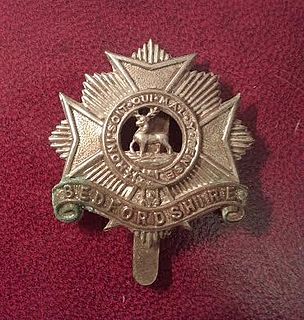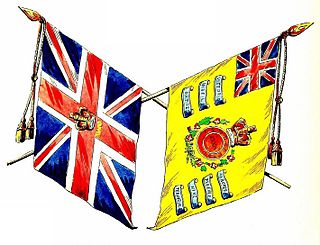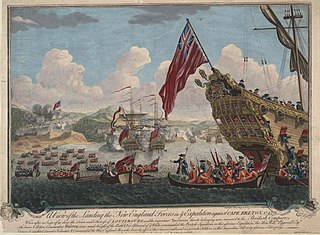
The 50th, or Shirley's Regiment of Foot was a British Army regiment first raised in 1745. [1]

The 50th, or Shirley's Regiment of Foot was a British Army regiment first raised in 1745. [1]
The regiment was first raised by William Shirley in New England as William Shirley's Regiment of Foot and ranked as the 65th Regiment of Foot in September 1745. [2] It was disbanded in May 1749. [2]
The regiment was re-raised in New England as the 50th Regiment of Foot (American Provincials) in December 1754 for service in the French and Indian War but, following the disastrous loss of Oswego, it was disbanded in December 1756. [2] [3]

Sir William Pepperrell, 1st Baronet was a merchant, soldier, and slaveholder in colonial Massachusetts. He is widely remembered for organizing, financing, and leading the 1745 expedition that captured the French fortress of Louisbourg during King George's War.
The 47th (Lancashire) Regiment of Foot was an infantry regiment of the British Army, raised in Scotland in 1741. It served in North America during the Seven Years' War and American Revolutionary War and also fought during the Napoleonic Wars and the Crimean War. Under the Childers Reforms it amalgamated with the 81st Regiment of Foot to form the Loyal Regiment in 1881.

The 32nd Regiment of Foot was an infantry regiment of the British Army, raised in 1702. Under the Childers Reforms it amalgamated with the 46th Regiment of Foot to form the Duke of Cornwall's Light Infantry in 1881.

The 29th (Worcestershire) Regiment of Foot was an infantry regiment of the British Army, raised in 1694. Under the Childers Reforms it amalgamated with the 36th (Herefordshire) Regiment of Foot to become the 1st Battalion, the Worcestershire Regiment in 1881.

The 50th Regiment of Foot was an infantry regiment of the British Army, raised in 1755. Under the Childers Reforms it amalgamated with the 97th Regiment of Foot to form the Queen's Own Royal West Kent Regiment in 1881.

The 56th Regiment of Foot was an infantry regiment in the British Army, active from 1755 to 1881. It was originally raised in Northumbria as the 58th Regiment, and renumbered the 56th the following year when two senior regiments were disbanded. It saw service in Cuba at the capture of Havana in the Seven Years' War, and was later part of the garrison during the Great Siege of Gibraltar in the American Revolutionary War. During the French Revolutionary Wars it fought in the Caribbean and then in Holland. On the outbreak of the Napoleonic Wars the 56th raised a second battalion in 1804 as part of the anti-invasion preparations; both saw service in India and in the Indian Ocean, with the first capturing Réunion and Mauritius. A third battalion was formed in the later years of the war, but was disbanded after a brief period of service in the Netherlands.

The Devonshire Regiment was a line infantry regiment of the British Army that served under various titles and served in many wars and conflicts from 1685 to 1958, such as the Second Boer War, the First World War and the Second World War. In 1958 the regiment was amalgamated with the Dorset Regiment to form the Devonshire and Dorset Regiment which, in 2007, was amalgamated with the Royal Gloucestershire, Berkshire and Wiltshire Regiment, the Royal Green Jackets and The Light Infantry to form a new large regiment, The Rifles.
The 38th Regiment of Foot was an infantry regiment of the British Army, raised in 1705. Under the Childers Reforms it amalgamated with the 80th Regiment of Foot to form the South Staffordshire Regiment in 1881.

The 31st (Huntingdonshire) Regiment of Foot was an infantry regiment of the British Army, raised in 1702. Under the Childers Reforms it amalgamated with the 70th (Surrey) Regiment of Foot to form the East Surrey Regiment in 1881.

The 51st, or Pepperrell's Regiment of Foot was a British Army regiment first raised in 1745.

The Bedfordshire and Hertfordshire Regiment was the final title of a line infantry regiment of the British Army that was originally formed in 1688. After centuries of service in many conflicts and wars, including both the First and Second World Wars, the regiment was amalgamated with the Essex Regiment in 1958 to form the 3rd East Anglian Regiment. However, this was short-lived and again was amalgamated, in 1964, with the 1st East Anglian Regiment and 2nd East Anglian Regiment, and the Royal Leicestershire Regiment to form the present Royal Anglian Regiment.

The 34th Regiment of Foot was an infantry regiment of the British Army, raised in 1702. Under the Childers Reforms it amalgamated with the 55th (Westmorland) Regiment of Foot to form the Border Regiment in 1881.

The King's Own Royal Regiment (Lancaster) was a line infantry regiment of the British Army. It served under various titles and fought in many wars and conflicts, including both the First and the Second World Wars, from 1680 to 1959. In 1959, the regiment was amalgamated with the Border Regiment to form the King's Own Royal Border Regiment.

The 40th Regiment of Foot was an infantry regiment of the British Army, raised in 1717 in Annapolis Royal, Nova Scotia. Under the Childers Reforms it amalgamated with the 82nd Regiment of Foot to form the Prince of Wales's Volunteers in 1881.
The 48th (Northamptonshire) Regiment of Foot was a regiment of the British Army, raised in 1741. Under the Childers Reforms it amalgamated with the 58th (Rutlandshire) Regiment of Foot to form the Northamptonshire Regiment in 1881.

General Staats Long Morris was a British Army officer and politician who sat in the House of Commons from 1774 to 1784, representing Elgin Burghs, and served as governor of Quebec from 1797 until his death in office. Born in British North America, Morris parlayed a marriage to a Scottish noblewoman into a successful career in Britain as a military officer and politician in the British Parliament.
The 58th (Rutlandshire) Regiment of Foot was a British Army line infantry regiment, raised in 1755. Under the Childers Reforms it amalgamated with the 48th (Northamptonshire) Regiment of Foot to form the Northamptonshire Regiment in 1881.

The siege of Louisbourg took place in 1745 when a New England colonial force aided by a British fleet captured Louisbourg, the capital of the French province of Île-Royale during the War of the Austrian Succession, known as King George's War in the British colonies.

The Raid on Canso was an attack by French forces from Louisbourg on the British outpost Fort William Augustus at Canso, Nova Scotia shortly after war declarations opened King George's War. The French raid was intended to boost morale, secure Louisbourg's supply lines with the surrounding Acadian settlements, and deprive Britain of a base from which to attack Louisbourg. There were 50 English families in the settlement. While the settlement was utterly destroyed, the objective failed, since the British launched an attack on Louisbourg in 1745, using Canso as a staging area.
The 101st Regiment of Foot was a regiment in the British Army raised in 1805 by Honourable Henry Augustus Dillon and disbanded in 1817. It was the last unit in the British Army to be raised through a contract with an individual.
{{cite web}}: CS1 maint: bot: original URL status unknown (link)